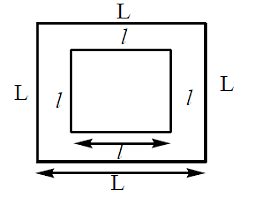Question:
For a current carrying inductor, emf associated is 20mV. Now, current through it changes from 6A to 2A in 2s. The coefficient of mutual inductance is
For a current carrying inductor, emf associated is 20mV. Now, current through it changes from 6A to 2A in 2s. The coefficient of mutual inductance is
Updated On: Apr 26, 2024
- 20 mH
- 10 mH
- 1mH
- 2 mH
Hide Solution
Verified By Collegedunia
The Correct Option is B
Solution and Explanation
$\left|e\right| = L \frac{dI}{dt} $
Here, $e = 20 mV = 20 \times10^{-3} V$
$ \frac{dI}{dt} = \frac{6-2}{2} = 2 \frac{A}{s }$
$ L = ? $
$\Rightarrow 20 \times10^{-3} = L \times 2$
$ \therefore \, \, \, L= 10 \times10^{-3} H = 10 \, mH$
Here, $e = 20 mV = 20 \times10^{-3} V$
$ \frac{dI}{dt} = \frac{6-2}{2} = 2 \frac{A}{s }$
$ L = ? $
$\Rightarrow 20 \times10^{-3} = L \times 2$
$ \therefore \, \, \, L= 10 \times10^{-3} H = 10 \, mH$
Was this answer helpful?
0
0
Top Questions on Inductance
- What is the self inductance of a solenoid of length 50 cm, if area of cross section is 10 cm2 and total number of turns is 600?
- CUET (UG) - 2023
- Physics
- Inductance
- If mutual inductance M=3H, L1=4H, L2=9H, then the coefficient of coupling will be equal to?
- MHT CET - 2023
- Physics
- Inductance
- The self-inductance of a solenoid is
- CUET (PG) - 2023
- Physics
- Inductance
- Find the mutual inductance in the arrangement, when a small circular loop of wire of radius ‘R’ is placed inside a large square loop of wire of side L (L << R). The loops are coplanar and their centres coincide:
- JEE Main - 2023
- Physics
- Inductance
- A small square loop of wire of side l is placed inside a large square loop of wire L(L>>l). As shown in figure, both loops are coplanar and their centers coincide at point O. The mutual inductance of the system is:

- JEE Main - 2022
- Physics
- Inductance
View More Questions
Questions Asked in VITEEE exam
- Two identical blocks A and B, each of mass 'm' resting on a smooth floor are connected by a light spring of natural length L and spring constant K, with the spring at its natural length. A third identical block 'C' (mass m) moving with a speed v along the line joining A and B collides with A. the maximum compression in the spring is
- VITEEE - 2023
- work, energy and power
- Assertion :
The binding energy of the nucleus increases with the increase in atomic number.
Reason :
Heavier elements have a greater number of non-radioactive isotopes than radioactive isotopes. - The half-life of radioactive radon is 3.8 days. The time at the end of which \(\frac{1}{20}th\) of the Radon sample will remain undecayed is (given log10e=0.4343)
- Which element has more electron gain enthalpy among chalcogen group?
- VITEEE - 2022
- sulphur
- Coin is tossed till heads is obtained what is expectation of no. of coin tosses
- VITEEE - 2022
- Random Variables
View More Questions
Concepts Used:
Inductance
Inductance is a key parameter in electrical and electronic circuit designs. Like resistance and capacitance, it is a basic electrical measurement that affects all circuits to some degree.
Inductance is used in many areas of electrical and electronic systems and circuits. The electronic components can be in a variety of forms and may be called by a variety of names: coils, inductors, chokes, transformers, . . . Each of these may also have a variety of different variants: with and without cores and the core materials may be of different types.
There are two ways in which inductance is used:
- Self-inductance: Self-inductance is the property of a circuit, often a coil, whereby a change in current causes a change in voltage in that circuit due to the magnetic effect of caused by the current flow. It can be seen that self-inductance applies to a single circuit - in other words it is an inductance, typically within a single coil. This effect is used in single coils or chokes.
- Mutual-inductance: Mutual inductance is an inductive effect where a change in current in one circuit causes a change in voltage across a second circuit as a result of a magnetic field that links both circuits. This effect is used in transformers.



